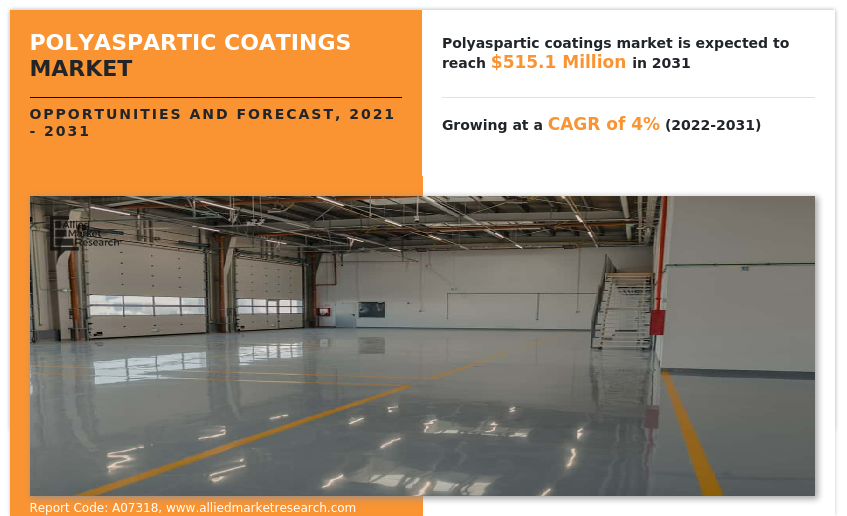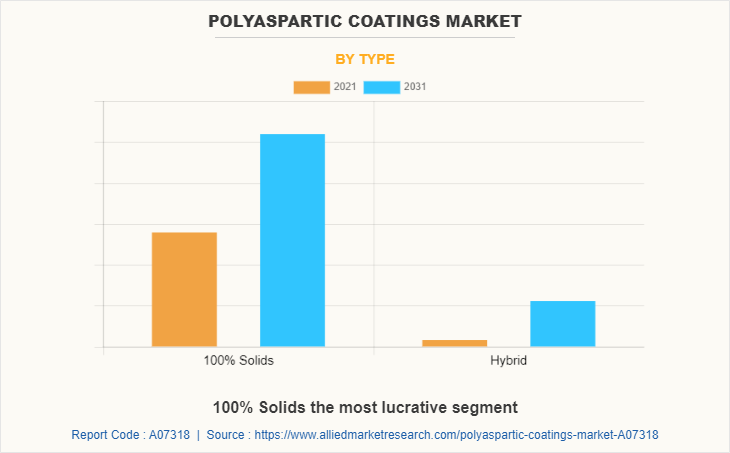Polyaspartic Coatings Market Research, 2031
The global polyaspartic coatings market size was valued at $347.6 million in 2021, and is projected to reach $515.1 million by 2031, growing at a CAGR of 4% from 2022 to 2031.
Polyaspartic coating, a protective layer of aliphatic polyurea is generally applied on concrete floor surfaces or metals. It can be either of 100% solid or hybrid type. It was firstly developed as a coating for steel bridges. It possesses excellent significant properties such as corrosion resistance, flexibility, and superior adhesion that make it best-suited for use in a wide range of end-use industries such as building & construction, transportation, industrial manufacturing, power generation, and others.

Increase in investments in building infrastructure in countries such as the U.S., China, Japan, Mexico, and India, have led the building & construction sector to witness a significant growth where polyaspartic coatings are used for flooring, wall finishing, and roofing applications. For instance, according to a report published by National Investment Promotion and Facilitation Agency, the infrastructure activities accounted for 13% share of the total foreign direct investment (FDI) inflows in 2021. In addition, sustainable economic growth coupled with increase in demand for consumer goods has led the automotive & transportation sector to witness a significant increase in demand where polyaspartic coating is widely used for corrosion protection applications in under hood parts, engine components, interior of containers, and storage vessels. These factors are predicted to contribute toward the global polyaspartic coatings industry growth.
However, the cost involved the formulation of polyaspartic coating is high that results in expensive final product. Furthermore, polyaspartic coatings are relatively expensive as compared to its other substitutes such as polyurethane and epoxy coatings. In addition to this, the production of polyaspartic coating required skilled workforce. These factors altogether may retrain the polyaspartic coatings market growth during the forecast period.
The polyaspartic coatings market is segmented into type, End-use Industry, and region. On the basis of type, it is divided into 100% solids and hybrid. On the basis of end-use industry, the market is classified into building and construction, transportation, power generation, industrial, and others. Region-wise, the market is studied across North America, Europe, Asia-Pacific, and LAMEA.
The major players that contribute strongly to the global polyaspartic coatings market share are Akzo Nobel N.V., BASF SE, Covestro A.G., CTM Coatings, Indmar Coatings Corporation, LATICRETE International, Inc, PPG Industries, Inc., ResinWerks, Rust-Oleum, and The Sherwin-Williams Company.
The global polyaspartic coating market report provides an in-depth competitive analysis as well as profiles of these major players.

In 2021, the 100% solids segment was the largest revenue generator, and is anticipated to grow at a CAGR of 4.2% during the forecast period. This is attributed to the fact that 100% solids type polyaspartic coatings are widely used as a seal coat on floors. The 100% solids type polyaspartic coatings has fast drying and curing capability that makes it best-suited for use as flooring topcoat in hospitals, malls, schools, and other building & construction sites. Furthermore, it is tough and durable as compared to other sold polyaspartic or polyurethane coatings. In addition, 100% solids type polyaspartic coatings contain minimal or no volatile organic compounds (VOCs) which in turn have increased its adoption among various end use sectors such as building & construction, power generation, aerospace, marine, and others. This factor is anticipated to increase the demand for 100% solids type polyaspartic coatings among various end use sectors; thus, boosting the growth of this segment in the global market.
Hybid segment was the second-largest contributor in terms of revenue in the global polyaspartic coating market in 2021, and is anticipated to grow at a CAGR of 3.7% during the forecast period. The utilization of polyaspartic coatings in sectors such as building & construction, industrial, transportation, and others is the major key market trend in the global market. In addition, rise in consumer goods has led the establishments of industrial manufacturing sector where hybrid type polyaspartic acid is widely used for industrial flooring applications. These factors have augmented the growth of the hybrid segment in the polyaspartic coating market.

By end-use industry, the industrial segment dominated the global market in 2021, and is anticipated to grow at a CAGR of 4.5% during forecast period. This is attributed to the increasing demand for consumer goods which in turn has surged the establishments of chemical manufacturing units in both developed and developing economies where polyaspartic coatings are widely employed as protective coating in various industrial equipment. This may positively drive the growth of the polyaspartic coating market during the forecast period. Moreover, the chemical manufacturing sector is witnessing a huge foreign direct investment (FDI) inflow attributed to attractive government policies and increasing demand from end user industries such as food processing, personal care, oil & gas, and others. For instance, according to a report published by India Brands Equity Foundation, the total FDI inflow in the Indian chemical sector reached $18.69 billion from April 2000 to June 2021.
Building and construction segment was the second-largest contributor in terms of revenue in the global polyaspartic coatings market in 2021, and is anticipated to grow at a CAGR of 3.9% during the forecast period. Rise in population led the building & construction sector to witness a significant growth where polyaspartic coatings are widely used for protective coating applications. For instance, according to a report published by International Trade Administration, China’s construction industry is projected to grow at an annual average rate of 8.6% from 2022 to 2030. This may propel the demand for polyaspartic coatings in the growing construction sector during the forecast period.

The Asia-Pacific polyaspartic coating market size is projected to grow at the highest CAGR during the forecast period, owing the fact that China's consumer electronics sector is increasing rapidly which in turn has enhanced the performance of the polyaspartic coating market in the region. According to a report published by the United Nations Statistics Division, China witnessed around 28.7% of the global manufacturing output for consumer electronic products in 2019. Also, countries such as India and Australia are witnessing a rapid increase in transportation sectors where polyaspartic coating is employed as protective coatings to provide structural integrity in transportation equipment and increase their average lifespan. For instance, according to a report published by the Indian Ministry of Commerce and Industry, the transportation sector in India is expected to grow at a compound annual rate (CAGR) of 5.9% owing to the development of highways, widespread railway networks, aviation ports, and waterways structure. This may enhance the performance of the polyaspartic coatings market in the Asia-Pacific region.
U.S. was the second-largest contributor in terms of revenue in the global polyaspartic coating market in 2021, and is anticipated to grow at a CAGR of 2.9% during the forecast period. The building and construction sector in the U.S. is increasing rapidly which in turn has increased the demand for sealing and concrete coating applications. According to a report published by the U.S. Census Bureau, the total construction spending during May 2021 was estimated at a seasonally adjusted annual rate of $1545.3 billion which is 7.5% above the May 2020 estimate of $1437.7 billion. This factor may propel the demand for polyaspartic coating market in the U.S.
Report key highlighters
- The polyaspartic coating market has been analyzed in both value and volume. The value of polyaspartic coating market is analyzed in millions while the volume is analyzed in tons.
- The polyaspartic coating market is consolidated in nature with few players such as Akzo Nobel N.V., BASF SE, Covestro A.G., PPG Industries, Inc., and The Sherwin-Williams Company that hold a significant shares of the market.
- Countries such as China, U.S., India, Germany, and Brazil hold a significant share in the global polyaspartic market. A detailed analysis on these countries covering niche applications is covered in this report.
IMPACT OF COVID-19 ON THE GLOBAL POLYASPARTIC COATING MARKET
- The polyaspartic coating market was negatively impacted due to the wake of the COVID-19 pandemic. However, the increasing awareness for using eco-friendly products among citizens of both developed and developing economies may surge the popularity of polyaspartic coatings with minimal or no VOC emissions in various end-use sectors including transportation, building & construction, industrial, aerospace, and others.
- Furthermore, the building & construction and transportation activities are projected to get back on track and start functioning at full capacity post-COVID-19 period which in turn may enhance the performance of the polyaspartic coating market during the forecast period.
Key Benefits For Stakeholders
- This report provides a quantitative analysis of the market segments, current trends, estimations, and dynamics of the polyaspartic coatings market analysis from 2021 to 2031 to identify the prevailing polyaspartic coatings market opportunities.
- Market research is offered along with information related to key drivers, restraints, and opportunities.
- Porter's five forces analysis highlights the potency of buyers and suppliers to enable stakeholders to make profit-oriented business decisions and strengthen their supplier-buyer network.
- An in-depth analysis of the polyaspartic coatings market segmentation assists to determine the prevailing market opportunities.
- Major countries in each region are mapped according to their revenue contribution to the global market.
- Market player positioning facilitates benchmarking and provides a clear understanding of the present position of the market players.
- The report includes an analysis of the regional as well as global polyaspartic coatings market trends, key players, market segments, application areas, and market growth strategies.
Polyaspartic Coatings Market Report Highlights
| Aspects | Details |
| Market Size By 2031 | USD 515.1 million |
| Growth Rate | CAGR of 4% |
| Forecast period | 2021 - 2031 |
| Report Pages | 255 |
| By End-use Industry |
|
| By Type |
|
| By Region |
|
| Key Market Players | IndMar Coatings Corporation, BASF SE, The Sherwin-Williams Company, PPG Industries, AkzoNobel, LATICRETE International Inc., SIKA AG, Resinwerks, Rust-Oleum Corporation, Covestro AG |
Analyst Review
According to CXOs of leading companies, the global polyaspartic coating market is expected to exhibit high growth potential. Polyaspartic coatings are used in pipelines, concrete floors, warehouses, hospitals, and others, for surface protection, material strengthening, and corrosion resistance purposes in a variety of end-use sectors such as building & construction, transportation, industrial, and others. Transportation and industrial equipment that require high strength, corrosion protection, and abrasion resistant properties can be accomplished with the use of polyaspartic coatings.
In addition, polyaspartic coating possesses excellent significant properties such as high mechanical strength, adhesion to metals, thermal resistance, chemical resistance, and corrosion resistance that makes it best suited for automotive coating applications. It serves as a protective coating in under hood parts and engine components owing to its scratch resistance property. Furthermore, factors such as flexibility in operation, ease of application, and minimal or no volatile organic compounds (VOCs) levels enhance performance of polyaspartic coatings in several end-use industries. CXOs further added that sustained economic growth and development of the building & construction sector have increased the popularity of polyaspartic coating.
The utilization of polyaspartic coatings in sectors such as building & construction, industrial, transportation, and others at it offers more resistant to UV exposure and its capability to hold color.
The industrial segment dominated the global market in 2021, and is anticipated to grow at a CAGR of 4.5% during the forecast period.
The Asia-Pacific is the largest market in the global polyaspartic coatings market.
The global polyaspartic coating market is projected to reach $515.1 million by 2031, growing at a CAGR of 4.0% from 2022 to 2031.
The global polyaspartic coating market profiles leading players that include Akzo Nobel N.V., BASF SE, Covestro A.G., CTM Coatings, Indmar Coatings Corporation, LATICRETE International, Inc, PPG Industries, Inc., ResinWerks, Rust-Oleum, and The Sherwin-Williams Company.
Loading Table Of Content...


